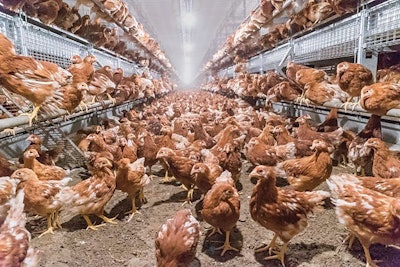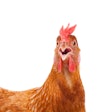
A survey of the Association of Veterinarians in Egg Production presented at the United States Animal Health Association annual meeting in October 2017 by Dr. Eric Gingerich, technical services specialist of poultry with Diamond V, gave interesting insights into the issues facing producers of cage-free eggs. Coccidiosis and related diseases, piling, cannibalism, E. coli, vaccinal infectious laryngotracheitis (ILT), Mycoplasma gallisepticum and roundworms were identified as the most important challenges in pullets and layers. In addition, other emerging or re-appearing conditions warrant monitoring.
Various diseases and control tactics
Veterinarians ranked coccidiosis as the most challenging disease in cage-free pullet production. Gingerich estimates that 95 percent or more layer pullets are given a coccidiosis vaccine, which requires good management practices to ensure success. The live oocyst vaccine needs to recycle two or three times through the bird to establish adequate immunity, so litter moisture and humidity management are important. Lack of adequate coccidiosis immunity allows secondary infections, most often necrotic enteritis, to develop. Both coccidiosis and necrotic enteritis result in increased mortality as well as reduced growth and egg production.
While more of a management than disease issue, piling was ranked second in the pullet survey as producers seek answers on how to prevent this phenomenon that causes significant mortality losses. There appears to be a strain relationship, as piling is commonly seen in brown birds and some strains of white pullets. Producers are learning that a uniform environment may reduce the incidence, so they are working to keep light intensity, temperature and litter depth consistent across the pullet house.

Increased reactions to live respiratory vaccines are observed when E. coli infections are present in growing pullets. After moving to the lay house, E. coli may contribute to significantly higher mortalities of 0.5 to 4 percent per week, as a secondary invader after respiratory issues may develop from high ammonia levels or disease challenges from mycoplasmas or infectious bronchitis. When water lines are contaminated with E. coli, this bacterium can be a primary pathogen. A live vaccine is used during pullet grow-out as a preventative and has also been used with success as a treatment during an outbreak.
Cannibalism is an important contributor to layer mortality and egg production losses. Management practices to help reduce cannibalism include proper beak trimming, lower light intensity, adequate space and nutritional interventions to ensure proper feathering. Producers are observing that hens in some aviary systems tend to crowd on one level, resulting in higher stress, nest competition and more pecking. Genetic differences have also been observed.
The lack of roundworm treatment for layers has been a significant issue because roundworm incidence increases in cage-free production. Maintaining dry litter is an important management tool, even leading to some producers building heated concrete floors in their houses. Until recently, there currently was not an approved treatment available in the U.S., but a product was approved in January 2018 for use both in pullets and hens in lay.
Organic flocks will not be able to benefit from this new treatment. Some producers have included diatomaceous earth, oregano or other essential oils in rations to help control roundworms.
Good vaccination programs have been generally successful in reducing the impact of Mycoplasma gallisepticum and vaccinal Infectious Larygnotracheitis. There are many vaccine choices for both diseases — vectored vaccines, mild and stronger strains that allow producers to choose a vaccine appropriate for the disease challenge. Vaccine application is extremely important for these products, and many are applied individually to ensure needed flock immunity is established.
Continued research
Several diseases that merit continued research and monitoring were reported as emerging or recurring in cage-free layers. Dr. Dan Wilson of Wilson Veterinary Company observes that the egg industry needs time to draw any solid conclusions on emerging pathogens. “Due to the long egg layer production cycle and lack of facilities to do controlled trials, we must rely on field experience to evaluate the impact of emerging or reemerging viruses, bacteria, protozoal and parasitic diseases. In the field, we also have many variables, such as age, bird strain, housing systems, feed and management, which further complicate our evaluation.”
Gallibacterium anatis is increasingly identified as an important secondary, and perhaps at times primary, pathogen causing septicemia. It is commonly isolated from the upper respiratory and lower reproductive tracts of healthy birds — and manifests itself with lesions in both areas very similar to E. coli. Many veterinarians feel this organism is responsible for reduced egg production and higher mortality. To date, this disease has been primarily observed in the Southeast where mortalities over 1 percent a week have been noted. The bacterium quickly develops resistance to antibiotics, and no vaccines are currently available in the U.S.
An emerging infectious bronchitis strain is of concern as an early infection may possibly be the cause of false layers — hens that ovulate normally, but the egg yolk is dropped into the abdominal cavity rather than being collected by the oviduct. Presumably, later infections appear to dramatically affect egg production and egg shell quality. There are reports of peak production percentages from 55 to 80 percent. Similar farm results have appeared in Pennsylvania, Wisconsin, Arizona and Colorado, to date. Researchers in Ontario, Canada, have classified a strain present there with a comparable clinical picture as a Delmarva type of infectious bronchitis. Producers are trying to minimize the impact by working on improved maternal antibody levels and adjusting pullet live bronchitis programs to get earlier active immunity with standard virus strains in an attempt to reduce the impact of this new strain.
Two diseases are more commonly seen in layers with outdoor access. One, Fowl Cholera (Pasteurella multocida), can be controlled by a variety of available vaccines. Unvaccinated flocks have experienced mortality up to 5 percent per day. The second, an emerging malady, Spotty Liver Disease, appears during wet weather and is now attributed to Campylobacter hepaticus, based on research from Australia and New Zealand. Producers are experiencing an increase in mortality of 1 to 2 percent per week as well as egg production drops of 5 to 10 percent. While the organism does seem to be susceptible to chlortetracycline, that option is not available in organic egg production.
Finally, in brown cage-free layers located in Western Ohio, producers have observed significant mortality resulting from secondary E. coli after an ulcerative dermatitis wound appears on the hens’ back. Losses have ranged from 0.5 to 4 percent a week. The source of the open ulcer is still being investigated.
Gingerich has compiled the annual review for 25 years. Participants score diseases and management problems both on prevalence and importance with a rating of zero to three. The reports provide valuable insights to the evolution of disease challenges over time.

















